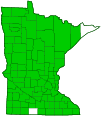cut-leaved coneflower
(Rudbeckia laciniata var. laciniata)
Conservation • Wetland • Description • Habitat • Ecology • Use • Distribution • Taxonomy
Description |
||
Cut-leaved coneflower is a 1½′ to 10′ tall, erect, perennial forb that rises on one or more stems from a fibrous roots and a horizontal, underground, somewhat woody stem (rhizome). It often forms colonies. A single stem or multiple stems rise from a rosette of basal leaves. The stem is erect, round in cross section, ridged, unbranched below the middle, and branched toward the tip. It is hairless; light green, bluish-green or purplish; and usually covered with a whitish, waxy coating (glaucous). Stem leaves are alternate. Basal and lowermost stem leaves are on long leaf stalks. The leaf blade is egg-shaped to broadly egg-shaped in outline, 6″ to 20″ long, and 4″ to 12″ wide. It is either deeply lobed (pinnatifid) with 3 to 7 lobes, or pinnately divided into usually 3, sometimes 5 or to 7, leaflets. The lobes are egg-shaped to elliptic or inversely egg-shaped and tapered to a sharp point at the tip. On both divided and lobed leaves the terminal leaflet is usually deeply divided into 3 lobes. The terminal lobe is shallowly, symmetrically lobed. The upper and lower surfaces are hairless or sparsely covered with short, stiff hairs and are also sometimes somewhat glaucous. The upper surface is smooth to the touch. The margins of the ultimate lobes and leaflets are untoothed, finely toothed, or coarsely toothed. The leaves become smaller, shorter stalked, and less divided or lobed as they ascend the stem. Middle and upper stem leaves have 5 to 9 lobes. Middle stem leaves are 3″ to 16″ long, and 1¼″ to 8″ wide with lance-shaped to egg-shaped or elliptic lobes. Upper stem leaves are unlobed or divided into 3 lobes and are sometimes unstalked. The inflorescence is a leafy, loose, flat-topped, corymb-like array of 2 to 25 flower heads at the top of the plant. The flower heads are showy and up to 3″ in diameter. The whorl of bracts at the base of the flower head (involucre) is ⅝″ to 1 3 ⁄16″ in diameter and narrowly saucer-shaped, more or less round with a shallow depth. It is composed of 8 to 15 bracts (phyllaries) in 2 overlapping series. The phyllaries are egg-shaped to lance-shaped and up to ¾″ long. The outer surface and the margins are sometimes hairless but more often moderately to densely covered with fine hairs, especially toward the base. The flower head has 8 to 12 ray florets and 150 to 300 or more disk florets. The ray florets are yellow, ellipse-shaped to inversely lance-shaped, ¾″ to 1¾″ long, and ¼″ to ⅝″ wide. They usually angle downward, sometimes droop downward, at the base of the receptacle. The receptacle is egg-shaped to globe-shaped, ⅜″ to 1″ long, and ⅜″ to ¾″ wide. It is covered with disk florets. The disk florets are ⅛″ to 3 ⁄16″ long and dull yellow to yellowish-green, with yellow lobes toward the tip. The fruit is a dry, one-seeded, ⅛″ to ¼″ long seed capsule (cypsela). The tip of the cypsela is flattened and has no hairs but a low crown. |
||
Height |
||
1½′ to 10′ |
||
Flower Color |
||
Yellow ray florets, dull yellow to yellowish-green disk florets |
||
Similar Species |
||
|
||
Habitat |
||
Moist. Woodland edges, stream sides. Full to partial sun. |
||
Ecology |
||
Flowering |
||
July to September |
||
Pests and Diseases |
||
|
||
Use |
||
|
||
Distribution |
||||
|
Sources |
|||
| 4/5/2023 | ||||
Nativity |
||||
Native |
||||
Occurrence |
||||
Common |
||||
Taxonomy |
|||
| Kingdom | Plantae (Plants) | ||
| Subkingdom | Pteridobiotina | ||
| Phylum | Tracheophyta (Vascular Plants) | ||
| Class | Magnoliopsida (Dicots) | ||
Order |
Asterales (Sunflowers, Bellflowers, Fanflowers, and Allies) | ||
Family |
Asteraceae (Sunflowers, Daisies, Asters, and Allies) | ||
| Subfamily | Asteroideae | ||
| Tribe | Heliantheae (Sunflowers and Allies) | ||
| Subtribe | Rudbeckiinae (black-eyed Susans, coneflowers, and prairie coneflowers) | ||
| Genus | Rudbeckia (black-eyed Susans and coneflowers) | ||
| Section | Macrocline | ||
| Species | Rudbeckia laciniata (cut-leaved coneflower) | ||
Subordinate Taxa |
|||
|
|||
Synonyms |
|||
Rudbeckia laciniata var. gaspereauensis Rudbeckia laciniata var. hortensis |
|||
Common Names |
|||
cut-leaved coneflower cutleaf coneflower green-headed coneflower tall coneflower wild golden-glow |
|||
Glossary
Bract
Modified leaf at the base of a flower stalk, flower cluster, or inflorescence.
Corymb
A flat-topped or convex inflorescence in which the stalked flowers grow upward from various points on the main stem to approximately the same horizontal plane. The outer flowers open first.
Cypsela
A dry, one-chambered, single-seeded fruit, formed from a single carpel, with the seed attached to the membranous outer layer (wall) only by the seed stalk; the wall, formed from the wall of the inferior ovary and also from other tissues derived from the receptacle or hypanthium, does not split open at maturity, but relies on decay or predation to release the contents.
Glaucous
Pale green or bluish gray due to a whitish, powdery or waxy film, as on a plum or a grape.
Pinnate
On a compound leaf, having the leaflets arranged on opposite sides of a common stalk. On a bryophyte, having branches evenly arranged on opposite sides of a stem.
Pinnatifid
Deeply cut, more than half way to the midrib but not to the midrib, into lobes that are spaced out along the midrib; the lobes do not form separate leaflets.
Receptacle
The thickened, upper part of a flower stalk to which flowers or flower parts are attached. In composite flowers, the part on which the flowers are borne. In accessory fruits the receptacle gives rise to the edible part of the fruit.
Rhizome
A horizontal, usually underground stem. It serves as a reproductive structure, producing roots below and shoots above at the nodes.
Visitor Photos |
|||||
Share your photo of this plant. |
|||||
| This button not working for you? Simply email us at info@MinnesotaSeasons.com. Attach one or more photos and, if you like, a caption. |
|||||
Alfredo Colon |
|||||
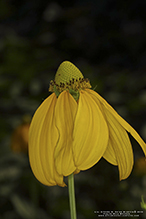 |
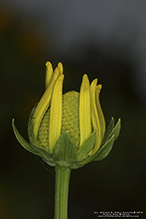 |
||||
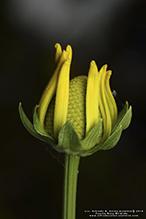 |
|||||
Bill Reynolds |
|||||
Was at the Old Treaty Crossing Festival Huot MN today. Came across a large patch of Cut-Leaf Coneflower which all abuzz with Honey Bees and Tricolored Bumble Bees. |
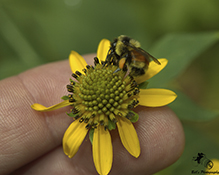 |
||||
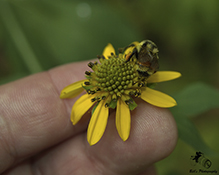 |
|||||
MinnesotaSeasons.com Photos |
|||||
Plant |
|||||
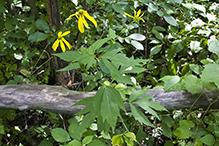 |
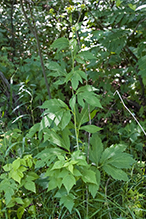 |
||||
Inflorescence |
|||||
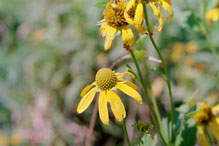 |
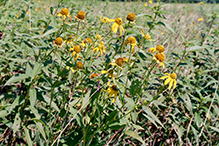 |
||||
Flower Head |
|||||
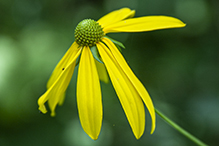 |
|||||
Leaves |
|||||
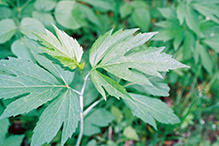 |
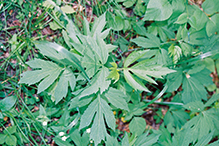 |
||||
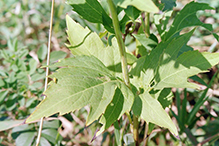 |
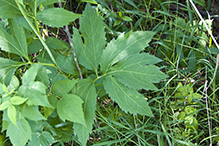 |
||||
Stem |
|||||
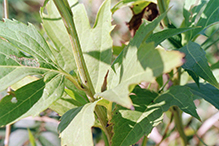 |
|||||

Slideshows |
||

Visitor Videos |
|||
Share your video of this plant. |
|||
| This button not working for you? Simply email us at info@MinnesotaSeasons.com. Attach a video, a YouTube link, or a cloud storage link. |
|||
Other Videos |
|||
| Published on Aug 24, 2012 Ionxchange |
|||
About
Published on Aug 24, 2012 Earthyman views Wild Goldenglow (Rudbeckia lanciniata) also known as Greenheaded Coneflower at Ion Exchange, native seed and plant nursery in NE Iowa. Wild Goldenglow is a great pollinator along your woodland edge. http://ionxchange.com/products/RUDBECKIA-LACINIATA-%7C-Wild-Golden-Glow.html |
|||

Visitor Sightings |
|||||
Report a sighting of this plant. |
|||||
| This button not working for you? Simply email us at info@MinnesotaSeasons.com. Be sure to include a location. |
|||||
| Alfredo Colon 8/2/2019 |
Location: Woodbury, Minnesota |
 |
|||
| Bill Reynolds 8/26/2017 |
Location: Red Lake Co MN Was at the Old Treaty Crossing Festival Huot MN today. Came across a large patch of Cut-Leaf Coneflower which all abuzz with Honey Bees and Tricolored Bumble Bees. |
 |
|||
MinnesotaSeasons.com Sightings |
|||||

|
Created: Last Updated: © MinnesotaSeasons.com. All rights reserved. |
